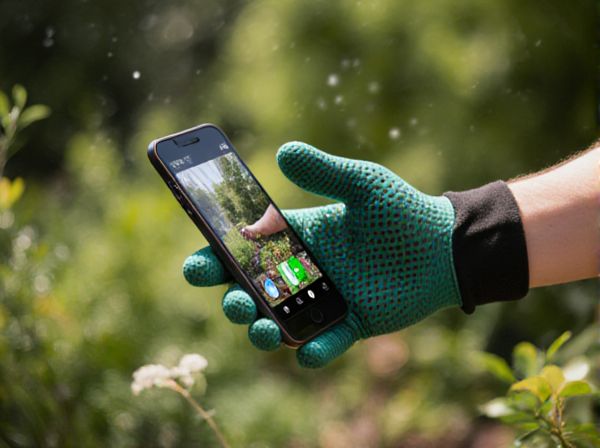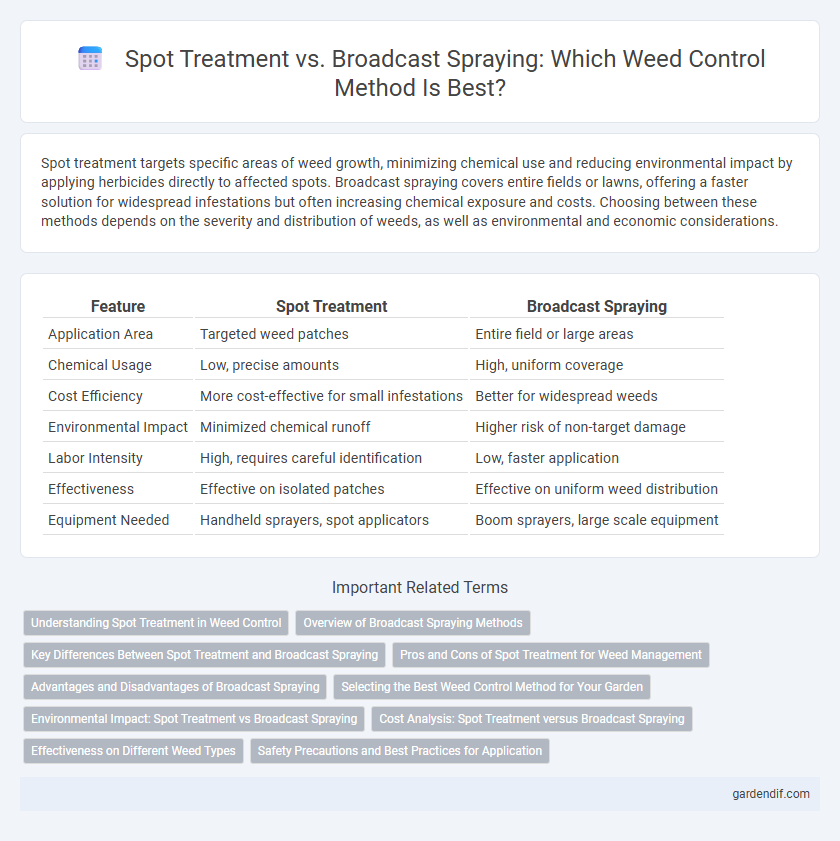
Spot treatment vs Broadcast spraying Illustration
Spot treatment targets specific areas of weed growth, minimizing chemical use and reducing environmental impact by applying herbicides directly to affected spots. Broadcast spraying covers entire fields or lawns, offering a faster solution for widespread infestations but often increasing chemical exposure and costs. Choosing between these methods depends on the severity and distribution of weeds, as well as environmental and economic considerations.
Table of Comparison
| Feature | Spot Treatment | Broadcast Spraying |
|---|---|---|
| Application Area | Targeted weed patches | Entire field or large areas |
| Chemical Usage | Low, precise amounts | High, uniform coverage |
| Cost Efficiency | More cost-effective for small infestations | Better for widespread weeds |
| Environmental Impact | Minimized chemical runoff | Higher risk of non-target damage |
| Labor Intensity | High, requires careful identification | Low, faster application |
| Effectiveness | Effective on isolated patches | Effective on uniform weed distribution |
| Equipment Needed | Handheld sprayers, spot applicators | Boom sprayers, large scale equipment |
Understanding Spot Treatment in Weed Control
Spot treatment in weed control targets specific weed patches with concentrated herbicide application, minimizing chemical use and reducing environmental impact. This method allows for precise management of invasive species, promoting healthier crop growth and lowering costs compared to broadcast spraying, which disperses herbicides over entire fields indiscriminately. Effective spot treatment relies on accurate weed identification and timely intervention to maximize eradication and prevent weed proliferation.
Overview of Broadcast Spraying Methods
Broadcast spraying involves applying herbicides uniformly across an entire field, targeting both weed patches and the crop area to prevent weed proliferation. Common methods include ground-based sprayers with boom arms for precise application and aerial spraying using drones or aircraft for large-scale coverage. This approach ensures a comprehensive weed control strategy, improving crop yield by minimizing weed competition.
Key Differences Between Spot Treatment and Broadcast Spraying
Spot treatment targets specific weed patches, minimizing herbicide use and reducing environmental impact, while broadcast spraying applies herbicides uniformly across an entire area for comprehensive weed control. Spot treatment is more precise and cost-effective for isolated infestations, whereas broadcast spraying is efficient for widespread weed problems but may increase chemical exposure. Choosing between the two depends on weed density, area size, and desired management outcomes.
Pros and Cons of Spot Treatment for Weed Management
Spot treatment targets individual weeds, reducing herbicide use and minimizing environmental impact compared to broadcast spraying. It allows precise application, preserving beneficial plants and lowering chemical resistance risks but can be labor-intensive and less effective for dense infestations. This method is ideal for localized weed problems, balancing efficacy with sustainability in weed management.
Advantages and Disadvantages of Broadcast Spraying
Broadcast spraying offers the advantage of efficiently covering large areas, making it ideal for controlling widespread weed infestations in agricultural fields. However, this method has the disadvantage of higher herbicide usage, increasing the risk of environmental contamination and potential harm to non-target plants. Precision is lower compared to spot treatment, often resulting in unnecessary chemical application and higher costs.
Selecting the Best Weed Control Method for Your Garden
Spot treatment targets individual weeds with precise herbicide application, minimizing chemical use and protecting surrounding plants, making it ideal for small infestations or sensitive areas. Broadcast spraying distributes herbicides evenly across larger areas, effectively managing widespread weed populations but increasing chemical exposure and potential harm to desirable flora. Selecting the best weed control method depends on garden size, weed density, plant sensitivity, and environmental impact, optimizing both efficacy and sustainability.
Environmental Impact: Spot Treatment vs Broadcast Spraying
Spot treatment minimizes environmental impact by targeting specific weed patches, reducing herbicide use and limiting chemical drift into surrounding ecosystems. Broadcast spraying disperses herbicides over large areas, increasing the risk of runoff, soil contamination, and harm to non-target plants and beneficial insects. Choosing spot treatment supports sustainable weed management practices and lowers ecological damage.
Cost Analysis: Spot Treatment versus Broadcast Spraying
Spot treatment significantly reduces herbicide usage by targeting specific weed infestations, lowering overall chemical costs and minimizing environmental impact. Broadcast spraying involves treating entire fields, leading to higher herbicide consumption and increased labor expenses, which amplifies total operational costs. For small or localized weed problems, spot treatment offers a more cost-efficient solution compared to the broader, more resource-intensive broadcast spraying method.
Effectiveness on Different Weed Types
Spot treatment targets specific weed patches with concentrated herbicides, offering high effectiveness on isolated or hard-to-reach weeds like broadleaf species and perennial grasses. Broadcast spraying covers entire areas uniformly, providing better control for widespread infestations and annual weeds but may result in overuse of chemicals. Selecting the appropriate method depends on weed type, density, and environmental impact considerations to optimize weed management outcomes.
Safety Precautions and Best Practices for Application
Spot treatment targets specific weed patches, reducing herbicide usage and minimizing environmental impact compared to broadcast spraying, which applies chemicals over a larger area. Safety precautions include wearing protective gear such as gloves, masks, and long sleeves to prevent skin contact and inhalation of chemicals. Best practices involve calibrating equipment properly, avoiding application during windy conditions, and following label instructions to ensure effective and safe weed control.
Spot treatment vs Broadcast spraying Infographic

 gardendif.com
gardendif.com